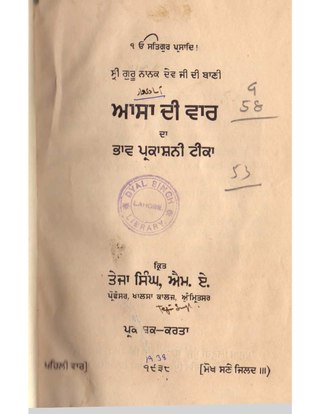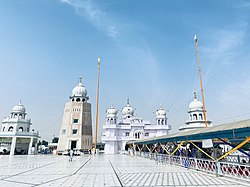
A gurdwara or gurudwara is a place of assembly and worship for Sikhs but its normal meaning is place of guru or "Home of guru". Sikhs also refer to gurdwaras as Gurdwara Sahib. People from all faiths and religions are welcomed in gurdwaras. Each gurdwara has a Darbar Sahib where the Guru Granth Sahib is placed on a takht in a prominent central position. Any congregant may recite, sing, and explain the verses from the Guru Granth Sahib, in the presence of the rest of the congregation.

The Damdamī Ṭaksāl, also sometimes referred to as Giani Samparda, Jatha Bhindra(n), or Sampardai Bhindra(n) is an orthodox Khalsa Sikh cultural and educational organization, based in India. They are known for their teachings of vidya as well as gurbanisanthiya. Its headquarters are located in the town of Mehta Chowk, approximately 40 km north of the city of Amritsar. It has been described as a seminary or “moving university” of the Sikh countryside.

Anandpur Sahib, also referred simply as Anandpur, is a city in Rupnagar district (Ropar), on the edge of Shivalik Hills, in the Indian state of Punjab. Located near the Sutlej River, the city is one of the most sacred religious places in Sikhism, being the place where the last two Sikh Gurus, Guru Tegh Bahadur and Guru Gobind Singh, lived. It is also the place where Guru Gobind Singh founded the Khalsa Panth in 1699. The city is home to Takhat Sri Kesgarh Sahib, the third of the five Takhts in Sikhism.

The Takht Sri Darbar Sahib Damdama Sahib, is one of the five takhts or Seat of Temporal Authority of Sikhism, located in Talwandi Sabo, near the city of Bathinda in Bathinda district of Punjab, India. At this place Guru Gobind Singh, the tenth Sikh Guru, prepared the full version of the Sikh scriptures called Sri Guru Granth Sahib in 1705. The other four Takhts are the Akal Takht, Takht Sri Keshgarh Sahib, Takht Sri Patna Sahib and Takht Sri Hazur Sahib.

Chamkaur Sahib is a Sub Divisional town in the district of Rupnagar in the Indian State of Punjab.

Baba Deep Singh is revered among Sikhs as one of the most hallowed martyrs in Sikhism. He is remembered for his sacrifice and devotion to the teachings of the Sikh Gurus. Baba Deep Singh was the first head of Misl Shaheedan Tarna Dal – an order of the Khalsa military established by Nawab Kapur Singh, the then head of Sharomani Panth Akali Buddha Dal. The Damdami Taksal also state that he was the first head of their order.

Mai Bhago also known as Mata Bhag Kaur, was a Sikh woman who led Sikh soldiers against the Mughals in 1705. She was an exceptionally skilled warrior on the battlefield and is revered as a warrior saint in Sikhism. She was known for rallying the 40 Sikhs who abandoned Guru Gobind Singh at the siege of Anandpur Sahib and bringing them back to fight.

Giani Gurdit Singh was born in Mithewal village in the state of Punjab, India. He was considered one of the greatest contemporary writers in Punjabi, and his book Mera Pind is regarded as a classic. It is now in its 14th edition and has been in print continuously since 1961. He was also a pioneering journalist, the Owner-Editor of Parkash from 1947–1978. He was also the editor of Singh Sabha Patrika, a monthly magazine of Sikh history and divinity. Giani Gurdit Singh graduated as "Giani" from Punjab University, Lahore in 1945, and he specialised in literature, divinity, history and folklore. He was a member of the Punjab Legislative Council from 1956 to 1962. He contributed to the debates at that time and in the creation of Punjabi University, Patiala and the recognition of Takht Sri Damdama Sahib, Talwandi Sabo, as the 5th Takht of the Sikhs. He was General Secretary of the Singh Sabha Shatabadi Committee, Amritsar, renamed Kendriya Sri Guru Singh Sabha. As the editor of the magazine Singh Sabha Patrika, he focused on issues of importance to the Sikhs. He also established two Guru Granth Vidya Kendras, one in Chandigarh and another in Mehrauli, Delhi.
The Khangura is a gotra of Jat community from the Punjab region in India.
Gurdwara Mata Sundri is considered to be one of the major historical Gurudwara of the Sikh; it is a landmark on the Mata Sundri road in the heart of Delhi. It is situated behind JP Nayak Hospital, the Gurudwara is a tribute to Mata Sundri, the wife of the 10th Guru – Guru Gobind Singh [4].

Gurdwara Damdama Sahib is a gurdwara located near Humayun's Tomb on the Outer Ring Road in New Delhi, India.

Hazur Sahib, also known as Takht Sachkhand Sri Hazur Abchalnagar Sahib, is one of the five takhts in Sikhism. The gurdwara was built between 1832 and 1837 by Maharaja Ranjit Singh (1780–1839). It is located on the banks of the Godavari River at the city of Nanded in the state of Maharashtra, India.
A takht, or taḵẖat, literally means a throne or seat of authority and is a spiritual and temporal centre of Sikhism. There are five takhts, which are five gurudwaras that have a very special significance for the Sikh community. Three are located in Punjab whilst the remaining two are located outside of it.

The Jathedar of the Akal Takht is the head of the Akal Takht and head of the Sikhs worldwide. The jathedar has the de facto power as the supreme spokesperson of the Khalsa to summon, trial and sentence any person who identifies as a Sikh from the Akal Takht.
Punjabi University Guru Kashi Campus (PUGKC) is a regional centre of Punjabi University, located at Talwandi Sabo, India. Its main constituents are Yadavindra College of Engineering, University School of Business Studies and Punjabi University Guru Kashi College.
Guru Kashi College is a constituent college of the Punjabi University in Talwandi Sabo, India. Established in 1964, it is one of the oldest college for arts and sciences in Malwa area of Punjab. It offers undergraduate and postgraduate programmes in sciences, humanities, social sciences, computer science and commerce.

A steek or teeka [other spellings may exist such as stik or tika] is an exegesis or commentary on a Sikh Religious Text, usually Gurbani, but can also include other writings like the Ghazals of Bhai Nand Lal. An author of a steek or teeka is known as a teekakar. A steek always includes an explanation, or viakhya of the specific religious text, but depending on the complexity of the steek, it can also include footnotes, commentary, and contexts to the specific verses and where they were first written/revealed.

Santhiya or Santhya is the correct pronunciation (ucharan) of Gurbani, taught in the manner of the 10th Sikh Guru, Guru Gobind Singh. It is comparable to the Islamic tajwid. Santhiya is almost always taught via a giani, who then teaches a vidyarthi (student). Educated vidyarthis can also teach other Sikhs santhiya. It involves the precise recitation and flow (rhythm) of the Gurbani that is being recited. Color codes to stop and pause, known as vishraams, are commonly used to dictate the flow and rhythm of the recitation. Gurbani which is recited by a person who has taken santhiya is known as "shudh ucharan"














